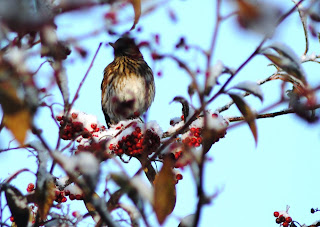This blog may help people explore some of the 'hidden' issues involved in certain media treatments of environmental and scientific issues. Using personal digital images, it's also intended to emphasise seasonal (and other) changes in natural history of the Swansea (South Wales) area. The material should help participants in field-based modules and people generally interested in the natural world. The views are wholly those of the author.
Wednesday, 29 December 2010
Wednesday, 22 December 2010
Tuesday, 21 December 2010
Winter Visitors
In Loughor, had a Red fox (Vulpes vulpes) roaming the garden at 2am. You can see the marks made by its brush along with its tracks in the snow. Also lots of evidence in the snow of bird visitors and a male Great spotted woodpecker (Dendrocopos major) frequented the feeder.
Monday, 20 December 2010
Birder's Bonus 87
Lots of activity in the Loughor berry trees with Redwing (Turdus iliacus) and Blackbird (Turdus merula) both scoffing.
Sunday, 19 December 2010
Seeing the Changes 337
In spite of the prevailing cold and snow the Grey squirrel (Sciurus carolinensis) were foraging. The Goat willow (Salix caprea) catkins in Loughor were even peeping through.
Saturday, 18 December 2010
Birder's Bonus 86
On the mudflats by the river Loughor, there were Redshank (Tringa totanus) and Dunlin (Calidris alpina). Lots of birds were feeding in the Loughor snow including Long-tailed tits (Aegithalos caudatus), Brambling (Fringilla montifringilla) and Redwing (Turdus iliacus).
Tuesday, 14 December 2010
Sunday, 12 December 2010
Saturday, 11 December 2010
Flutterby!
I very much like butterflies but I have to wonder whether the decline of some species in Europe (blamed on the effects of changing agricultural practices leading to fewer flower-filled meadows) needs to be reversed by going back to older production techniques (http://www.guardian.co.uk/environment/2010/dec/09/grassland-butterflies-decline-europe ). Presumably, the now threatened species were not so common before meadows were created and extended by human activities. It would seem better to uncouple the link between agriculture and the encouragement of these attractive species (very clearly a 'human' choice).
Friday, 10 December 2010
A Star Turn?
The story that materials extracted from the slime surrounding Scottish starfish may prove to be of medical importance seems just a bit premature (http://www.bbc.co.uk/news/science-environment-11931039). The starfish produce their 'goo' to prevent their surfaces being colonised by other species that surround them in their sea environment. In deed, the agents are described as being more effective than Teflon. The people involved in these studies suggest that these chemicals may give rise to drugs benefiting asthma, hay fever and arthritis patients. One could even suggest that drugs preventing materials sticking to the inside of blood vessels may result. What about chemicals preventing the build up of plaque on teeth? These materials are, however, a long way from generation (if they result at all). I seem to remember that claims about the plethora of potential agents to be extracted from marine organisms were made more than 30 years ago. There have been a few successes but these are very few and far between.
Wednesday, 8 December 2010
Birder's Bonus 82
A Lapwing (Vanellus vanellus) has taken to foraging amongst the molehills beside the Llanelli bypass.
Saturday, 4 December 2010
Birder's Bonus 81
The cold spell must be playing havoc with birds. On the estate in Loughor, saw a Grey heron (Ardea cinerea) perched on a garden fence!
Friday, 3 December 2010
Birder's Bonus 80
After feeling left out ot it, we finally got a sprinking of snow on the Gower-Carmarthenshire border. This seemed to stimulate many birds. At Loughor Bridge, a Buzzard (Buteo buteo) was being mobbed by 2 Carrion crows. There and all along the estuary, there was lots of Cormorant (Phalacrocorax carbo) activity. At Bynea, I noted the footmarks of a skating Moorhen (Gallinula chloropus). At Penclacwydd, Lapwing (Vanellus vanellus) fed in the fields and a Song thrush (Turdus philomelos) looked for snails to break on the cycle path.
Subscribe to:
Comments (Atom)
-
I n the UK and US, a pparently popular and successful vegan/vegetarian restaurants are reportedly closing or adding meat to their menus ( ...
-
Early ripening fruit may seem convenient but some folk think it confirms environmental stress. There's also a possibility th...






























%20mating%20NWCW.jpg)

